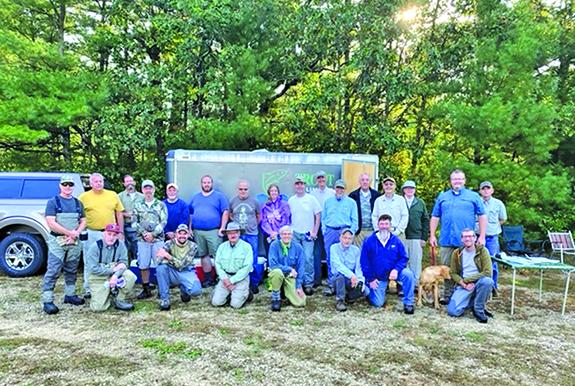The 2022 stream restoration season is drawing to a close, after another successful year of collaboration between the Wild Rose Wis DNR Trout Habitat Management Team (WDNR THMT) and Trout Unlimited Chapters from the Central Region of Wisconsin.
Stream restoration has been on-going in Central Wisconsin since the 1930’s when the Works Progress Administration funded projects under the auspices of the Wisconsin Conservation Commission and Department. At that time policy makers believed investment of public funds in our trout streams was a worthwhile undertaking. The remnants of these early projects are still evident today upstream of the County T bridge crossing the West Branch White River, west of Wautoma.
Methods of trout stream restoration were developed and refined by research conducted in the 1960’s through the 1980’s. Robert Hunt, fisheries research biologist Wisconsin Department of Natural Resources, directed and conducted the research, most of it centered in Central Wisconsin. Hunt, a local resident to the region, lived in Waupaca and was an avid trout fisher. Being a trout fisher likely provided useful insight into restoration development.
Many of our regional streams benefited from the application of Hunt’s effective means to enhance trout populations. His book titled Trout Stream Therapy, published in 1993, became the standard text for trout stream restoration at that time across North America for many years and was also used as a guide to restoration in Europe.
Funding sources also developed over these years to partially cover the costs of restoration. One of several sources began in 1950, when the Funding Federal Aid in Sport Fish Restoration Act became law (Dingell-Johnson Act). The act generated funds via a 10 percent excise tax on the sale of some fishing tackle and the funds are apportioned to state fish and wildlife agencies to support recreational fishing. A Wisconsin specific source is the Wisconsin Trout Stamp program, that requires purchase of a stamp to fish in-land trout. The Inland Waters Trout Stamp program was created to provide funding for improving and restoring trout habitat and to provide increased trout fishing opportunities. The legislation enacting this program was introduced to the Wisconsin legislature by then legislator Jon Wilcox (Supreme Court Justice Retired) in 1977. All stamp funds go directly to trout restoration.
Throughout recent years, restoration methods continue to evolve and improve, as a result of the experiences generated by the Wild Rose WDNR THMT’s work, lead by Shawn Sullivan and supported by Steve DeVitt and Kyle Seibers in conjunction with several Limited Term Employees. Funding sources have also evolved to include financial grants obtained by regional Trout Unlimited chapters that formed TU CARES (Trout Unlimited Central Area Restoration Effort for Sustainability). The benefits of the combined effects of refined methods and additional funding means are evident in current restoration activities are those focused on the West Branch White River, Bird Creek, Caffee Creek and Kiminski Creek, among other streams.
The attached picture shows our typical workday crew comprised of TU volunteers and WDNR professionals that collaborate in restoring rivers. While the Wild Rose WDNR THMT works full-time on streams, TU volunteers meet to support the work on the third weekend of May through September from 8 a.m. to noon when a fantastic lunch is provided. The public is welcome to participate with us. We are thankful to Chad Tucker (Central Wisconsin Trout Unlimited) for organizing the TU volunteers for workdays.


